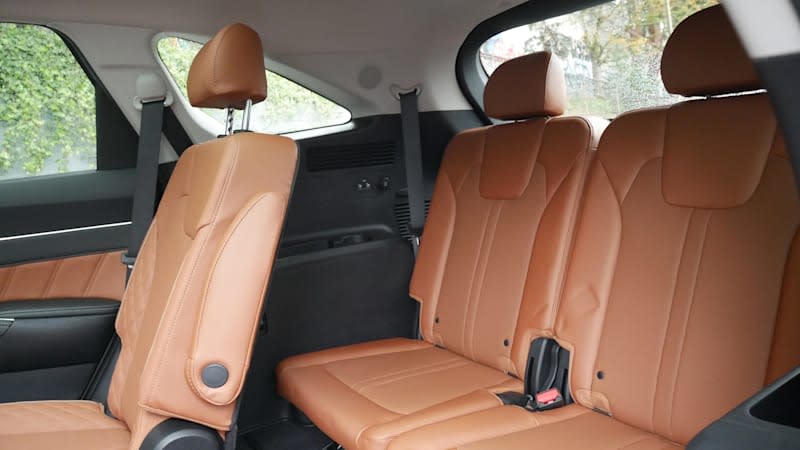2022 Kia Sorento Review | A different sort of 3-row SUV

The 2022 Kia Sorento is a different sort of three-row SUV, and that's actually the main reason to consider one. For starters, it's smaller than the others, making it more manageable to drive for those who'll only need that extra row on rare occasions – which isn't an unusual use case. At the same time, it's still larger than compact SUVs, including the few that have three rows themselves. Then there's what's going on under the hood (and floor). The Sorento offers four powertrain choices, most notably the regular Sorento Hybrid that gets 37 mpg combined and the new 2022 Sorento PHEV plug-in hybrid that'll travel 31 miles on electricity only.
There are plenty of other reasons to like the Sorento, especially inside where you'll find an attractive cabin with high-quality materials and easy-to-use tech. In that way, it's not that different from Kia's bigger and wildly popular Telluride. The fact you'll likely have an easier time finding a Sorento than a Telluride is another point in the smaller three-row Kia's favor. In the end, not every car has to have an apples-to-apples competitor, and although the Toyota Highlander perhaps comes the closest, the unique Sorento proves that being different can be a good thing. It's one of our choices for best midsize SUV.
Interior & Technology | Passenger & Cargo Space | Performance & Fuel Economy
What it's like to drive | Price & Features | Crash Ratings & Safety Features
What's new for 2022?
The Sorento welcomes Kia's new badge, and more important, a plug-in hybrid powertrain to the family for 2022. It also expands the availability of the X-Line package beyond the priciest trim levels to the S and EX. In fact, every all-wheel-drive S and EX are now X-Lines. That means only the base LX and the sporty SX can be had with AWD and not X-Line. Other updates include the 10.25-inch touchscreen now standard on all but the LX. The range-topping SX Prestige gains standard heated second-row captain's chairs and additional adjustments for the driver seat.



What's the Sorento interior and in-car technology like?
The Sorento has a high-quality interior with a distinctive design. Although there's less space than in a Telluride (more on that in the next section), you're not really losing anything in terms of ambiance or feature content. The main difference between Sorento trim levels, besides features, is the strip of dash trim in front of the passenger and the fanciness of upholstery. Besides being either cloth or leather, the latter gets a quilted look in the SX trim and the option of a snazzy blue color (pictured below right) in the PHEV. The hybrid models also get a rotary transmission selector instead of the traditional PRND stick, pictured below left.
Technology is a highlight for the Sorento and gets better for 2022 as all but the base LX get the horizontally oriented 10.25-inch infotainment touchscreen. It's user-friendly, feature-packed and one of our favorite interfaces on the market (though admittedly, some things on the right side of the screen are a bit of a reach). Upper trim levels also get a vibrant 12.3-inch all-digital instrument display. The kids should appreciate that there are eight USB ports in all but the LX, which "only" has six.


How big is the Sorento?
The Sorento has three rows of seats and is considered a midsize crossover, but it's considerably smaller than other vehicles described as such. It's 8 inches shorter in length than the Telluride and 4 inches narrower, which is significant. It also has nearly 2 fewer inches of third-row legroom (plus a seat that's much closer to the floor and therefore less comfortable) and 3.1 fewer inches of middle-row shoulder room. Those are two dimensions most likely to make a difference when loading up with people. All that said, the Telluride is one of the biggest vehicles in the segment, and the Sorento isn't that far off the pace. It even has more third-row space than the Toyota Highlander. It's also important to note the Sorento has basically the same exterior dimensions as two-row midsize crossovers like the Honda Passport and Hyundai Santa Fe -- in that way, the third row can basically be thought of as a bonus feature for occasional use.
One thing to keep in mind: a second-row bench seat is optional on most trims, meaning there is frequently only six seats aboard with the second-row captain's chairs and two-person third row. Most three-row crossovers these days have seatbelts for seven or eight depending on the middle seating row. Access to that third row could also be better as the second-row just doesn't slide leave much of a gap when slid forward.
Cargo space with the third-row lowered (38.4 cubic-feet) and all seats lowered (75.5) is better than what you'll get in most two-row midsize SUVs (and roughly what you get in a Honda CR-V or Toyota RAV4). Where it really suffers relative other three-row crossovers is cargo space behind the raised third row. Its mere 12.6 cubic feet trails all those bigger three-rows considerably, and in terms of actual luggage, could barely fit two carry-on roller suitcases in our testing. As such, using all three rows is something that's unlikely to be done for lengthy journeys, unless your family pack really light or invest in a roof-top carrier.




What are the Sorento fuel economy and performance specs?
The 2022 Sorento LX and S trim levels come standard with a 2.5-liter inline-four that produces 191 horsepower and 182 pound-feet of torque. A traditional eight-speed automatic and front-wheel drive are standard, with all-wheel drive an option. Although engine output is similar to what you'd find in a CR-V or RAV4, the Sorento's greater weight results in slower acceleration – Kia says this engine will get the Sorento from 0-62 mph (100 km/h) in 9.5 seconds. EPA-estimated fuel economy is 24 mpg city, 29 mpg highway and 26 mpg combined with FWD and 23/25/24 with AWD.
The various EX and SX trim levels get a 2.5-liter turbocharged inline-four that produces 281 hp and 311 lb-ft of torque – an output that exceeds that of bigger three-row SUVs. Its 0-62 time is 7.4 seconds, which is more competitive but hardly eye-popping given the available power and how quick it immediately feels off the line. A lot of credit goes to all that torque. This engine is paired with an eight-speed dual-clutch automated manual transmission that for all intents and purposes behaves like any old automatic. Fuel economy is 22 mpg city, 29 mpg highway and 25 mpg combined with FWD and 22/27/24 with AWD.
The fuel economy champs are the hybrids, however. The standard Sorento Hybrid features a combination of 1.6-liter inline-four and and a single motor for a combined output of 227 hp and 258 lb-ft of torque. Unlike most other hybrids, it relies on a traditional six-speed automatic transmission resulting in it feeling a bit more normal behind the wheel. Its 0-62 time falls in between the two above engines at 8.6 seconds. Fuel economy is 39 mpg city, 35 mpg highway and 37 mpg combined with FWD and 36/33/35 with AWD. This effectively matches the other three-row hybrid, the Toyota Highlander.

 Yahoo Autos
Yahoo Autos 
